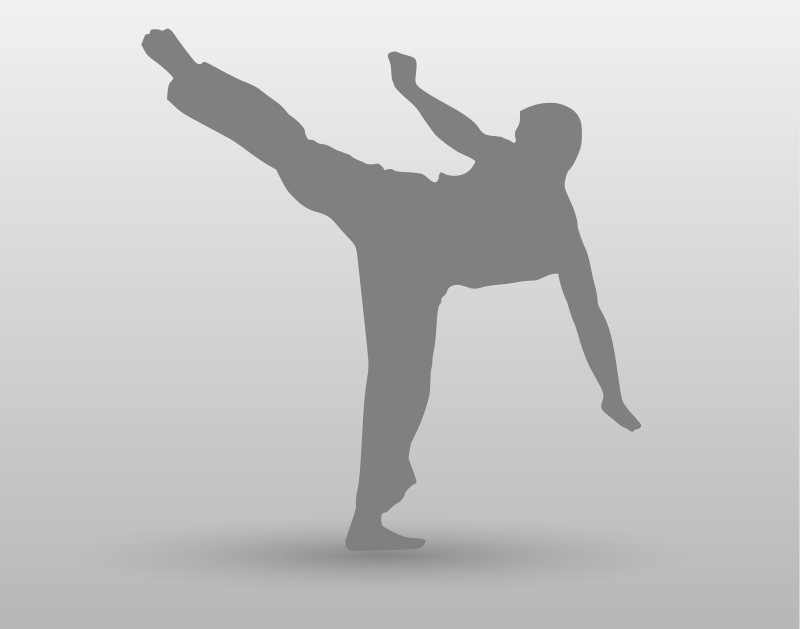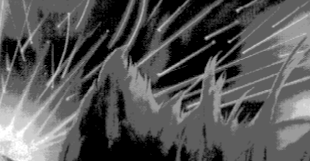Rules
Cyno's Role-Play provide a set of basic rules in order for games that involve combat to remain fair, yet fun to play. This section describes the set of basic rules.
Turn
Each turn could be as long as appropriate (determined by the GM); usually 5 to 10 minutes. Each combat turn is generally only 10 seconds.
Order of Gaming
Each combat turn is less free-flowing than a role-playing turn. There are specific order at which things occur. This section outlines the order of each combat turn.
- GM describes the situation.
- Roll initiative for all PC and NPC.
- Characters perform their actions, ordered by initiative.
- Turn ends. Go back to step one for the next turn.
Initiative
When determining initiatives, you should use a die that has more sides than the number of player characters and the number of non-player characters combined. So if you have four PCs and two NPCs, then you should roll 1D8.
If a 20, 30, or a die with even more sides is used, then for every 2 points of reflex higher than 12 the character gets 1 point bonus added to the roll (-1 penalty for every 2 points below 9).
The person with the highest roll goes first. When two or more characters have the same initiative, a separate roll is determined between the characters to determine initiative.
A character does not have to make a move every turn. Let us say Kristine, Rachel, and Sid rolled initiative. Kristine rolls highest, Rachel rolls second highest, and Sid rolls lowest. Kristine makes the first move. When Rachel receives her turn, she could simply pass. Rachel will, thus, do nothing on that turn. But if she is attacked, she will still be able to defend (dodge, etc.).
Holding Back Initiatives
Characters may hold back their initiatives. For example, Rachel could declare, on her turn, that she is going to hold back her turn until Sid moves. In this case, Sid would move before Rachel. If Sid were to declare that he is going to go after Rachel, then a die roll is made to decide whose patience runs out first. Each character rolls a 20-sided die, add or subtract bonus/penalty (+1 for every 2 points higher than 12 on the stress attribute, -1 for every 2 points lower than 9) from the die roll. The person with the higher result wins, therefore moves after the person with the lower result.
Ambush
Holding back initiative is very useful in some situations. In an ambush, for an instance, the ambushing character might have rolled a higher initiative than the victim. Because of the circumstance, the ambushing character has no desire to make a move until the victim has made a move (e.g. entering a room), the ambushing could declare a hold back on initiative. Since the victim have no knowledge of this action or even that the ambushing character is sitting there waiting, it is not possible for the victim to declare a hold back of his/her initiative. Thus, the ambushing character need not waste a turn by doing nothing.
Surprise and Being Surprised
During the game, a character may be surprised. In such a situation, a GM should roll 1D6 to determine, for each of the character that may be surprised, whether the character is surprised or not.
|
Surprise Chart |
|
|
1 - 2 |
Surprised, miss the whole turn. |
|
3 - 4 |
Surprised, loose initiative. |
|
5 - 6 |
Not surprised. |
Actions
The actions value, determined through Character Creation determines how many actions the character can perform each combat turn.
Combat
Combat is the core of most role-playing games. Having some action in between role-playing keeps the game fun and refreshing.

Roll to Strike
The attacker rolls 1D20 to strike. If the roll is 5 or lower, it is an automatic miss. A roll of 20 is automatic hit. Critical hit applies when rolling a 19 or a 20.
For every 2 points of coordination higher than 12, the character receive 1 point for bonus. For every 2 points of coordination below 9, the character subtracts 1 point for penalty.
Consult the bonus/penalty charts below. Select the appropriate bonuses and penalties. Add or subtract the total bonus or penalty from the roll. If the final result is higher than 10, then the attacker has hit the target.
|
Bonuses |
|
|
+1 |
Striking at a large target. Anything over 3 meters. |
|
+0 |
Weaponry skill between 51 & 60%. |
|
+1 |
Weaponry skill between 61 & 70%. |
|
+2 |
Weaponry skill between 71 & 80%. |
|
+3 |
Weaponry skill between 81 & 90%. |
|
+4 |
Weaponry skill between 91 & 100%. |
|
+1 |
Target is within a short range. |
|
Penalties |
|
|
-1 |
A forth of the target is behind cover. |
|
-2 |
Half of the target is behind cover. |
|
-3 |
Three forth of the target is behind cover. |
|
-1 |
Striking at a small target. Anything under 30 centimeters. |
|
-2 |
Striking from a moving vehicle. |
|
-1 |
Striking while moving slowly (e.g. walking, etc.). |
|
-2 |
Striking while moving quickly (e.g. running, etc.). |
|
-1 |
For every 5 damage points the attacker has lost. |
|
-1 |
Target is moving slowly (e.g. walking, etc.). |
|
-2 |
Target is moving quickly (e.g. running, etc.). |
|
-5 |
Weaponry skill lower than 11%. |
|
-4 |
Weaponry skill lower than 21%. |
|
-3 |
Weaponry skill lower than 31%. |
|
-2 |
Weaponry skill lower than 41%. |
|
-1 |
Weaponry skill lower than 51%. |
Aimed Hits
A character may aim at the target. Aiming takes one or more actions in addition to the actions needed to use the weapon. But if a hig is aimed, the strike roll is increased by the number of actions spent on aiming. Also an aimed hit does not hit the target at a random location like a regular hit. The character may specify a hit location. To hit the exact location, a percentage roll is made against the weapon skill. If the skill check fails, then the hit is close, but not exact.
Dodging
When the attacker is using a hand-to-hand weapon, it is possible for the defender to dodge the attack. Dodging costs an action to perform. Dodging must be declared before roll to strike occurs. Which means that even if the attacker missed, the defender would still use up an action on dodge.
To calculate whether the character succeeds at dodging the attack, roll a twenty-sided die for each hit. For every 3 points of reflex over 12, one point is added to the roll. For every 2 points of reflex under 9, one point is subtracted from the roll.
Calculate any bonus or penalty into the result. If the result is the same or higher than the result of the strike roll, then the character has successfully dodged the attack.
A character may not dodge/parry if the character does not know that he/she is being attacked. For example, if the character is being hit from the back. See Blind Dodge in the next section.
Blind Dodge
Blind dodge is an action like dodging. It is done when the character knows that he/she is being attacked, but do not see the attack; a blow from the back. But perhaps, the character heard a sound and knows he/she must get out of the way. Since the character does not know where the attack is coming from, it has a 50/50 chance of succeeding at an attempt to dodge the attack.
First, roll percentage die for the character. If it is 50 or under, then the attempted blind dodge is successful. Simply roll to dodge as before defined in the previous section. If the percentage roll is higher than 50, then the character was unable to dodge the attack.
Like dodging, blind dodge costs one action to perform and must be declared before roll to strike.
Parrying
A character may also block the enemy's blow with a weapon or a limb, allowing the weapon or limb to take the damage instead. This action is called parrying. Compute result the same way as dodging. Parrying cost an action for character that has no hand-to-hand combat skill. If the character has hand-to-hand combat skill, it must apply the skill and roll a percentage die. If successful, the attack is blocked without costing an action.
Roll Damage
When the target has been hit, a damage roll is applied. Consult the weapon for the amount of damage applied. Critical strike does double damage.
Damage Rating
Everything (well, almost everything) has damage points. Damage points are based on the metric system and its notation for easy understanding, easy usage, and flexibility. We call this system the damage rating. Following is a chart of the metric system:
|
Metric System |
||
|
Prefix |
Symbol |
Conversion |
|
Exa |
E |
0.000000000000000001 |
|
Peta |
P |
0.000000000000001 |
|
Tera |
T |
0.000000000001 |
|
Giga |
G |
0.000000001 |
|
Mega |
M |
0.000001 |
|
Kilo |
k |
0.001 |
|
Hecto |
h |
0.01 |
|
Deka |
da |
0.1 |
|
- |
- |
1 |
|
Deci |
d |
10 |
|
Centi |
c |
100 |
|
Milli |
m |
1,000 |
|
Micro |
u |
1,000,000 |
|
Nano |
n |
1,000,000,000 |
|
Pico |
p |
1,000,000,000,000 |
|
Femto |
f |
1,000,000,000,000,000 |
|
Atto |
a |
1,000,000,000,000,000,000 |
The basic unit is meter, gram, liter, and etc. In this case, it would be damage points. Like other metric units, damage points has an abbreviation: DP (Damage Point). Notation for the damage rating system is just like the regular metric system. MDP stand for Mega Damage Point, nDP stand for Nano Damage Point. Noticed that the symbol n is in lower case.
The numbers in the conversion column are equivalent. For example, 10 listed under deci is equivalent to 0.1 deka, and, of course, they both equal to 1 in basic unit. Conversion from one level to another is also easy and just like the metric system. One daDP equals ten DP. All you have to do is move the decimal point. To move up the chart, move the decimal to the left; to move down, move the decimal to the right. For each level between the range of milli and kilo, move the decimal one place.
Noticed that there are two levels between Kilo and Mega. There are no names for them. Instead, we will call them Kilo+1 for one level above Kilo and Kilo+2 for two levels above Kilo. The same applies to levels between Mega and Giga, and any other levels without a name. Notation for Kilo+1 Damage Point is k+1DP.
Cyno's Role-Play uses the metric system because it contains various levels. Each level represents a different level of destruction. One example is the indestructible tank (hDP). Anyone can attack the tank with a fist, a bat, and and a 9mm handgun, but the tank will take no damage from these weapons. The reason is that the fist, the bat, and the 9mm handgun are all rated at DP. DP weapons are two destruction levels below hDP, therefore does no damage to the hDP tank.
If the character happens to be carrying a rocket launcher, which does kDP, then the tank is in trouble. Why so many levels? For flexibility. Have you ever seen a movie or animation where a space ship is able to destroy a planet? A planet must be stronger than a tank. It must be several destruction levels higher than the tank; maybe in the giga or tera range.
Static Damage Point
Static damage point is like damage point except that they do not change from level to level. Its notation is SDP. For example, if you have a weapon that does 5 ShDP (Static Hecto Damage Point), it would do 5 damage points whenever it hit an object with hDP. But when your weapon hits a daDP object, it would still do only 5 daDP. Even if the weapon hits an object with cDP, it would still only do 5 damage points.
Healing
Characters do not generally heal by themselves. Instead, they must seek medical attention. If they do not, their wounds or illness may become worse.
Rockets
Rockets are unguided projectiles. They are shot like any other projectile weapons. Since rockets propel themselves, they have the tendency of moving in crooked lines. Because of this, they have a -2 penalty to hit.
Missiles

All missiles are guided. Guided missiles are also considered as "fire and forget" weapons. Once your tracking camera is on target, it is just a matter of waiting for lock-on. Since missiles are guided, a character can not aim a missile at a target. The bonus and penalty of the character does not apply.
Firing Missiles
Missiles are fired in volleys. Each volley may consist of as many missiles as the vehicle can fire in one action. Each voley of missiles may be directed at only a single target. So if five missiles are fired in one volley, they either all hit the target or all miss the target.
Dodging Missiles
It is possible to dodge missile volleys consist of four or less missiles by using the dodging rule. But if the volley consists of five or more missiles then it would not be possible to dodge the volley.


